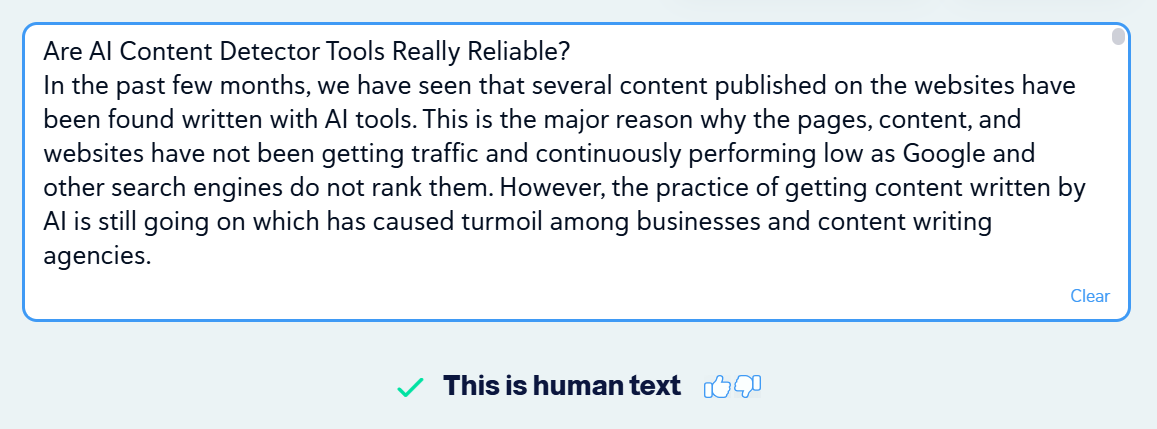📧 mithvin@gmail.com
📞+91 900 608 4701


In the past few months, we have seen that several pieces of content published on websites have been found to have been written with AI tools. This is the major reason why the pages, content, and websites have not been getting traffic and are continuously performing low, as Google and other search engines do not rank them. However, the practice of getting content written by AI is still ongoing, and this has caused turmoil among businesses and content writing agencies.
One of the major problems these days is that businesses fear that content writers will generate articles using AI tools, which may cause their websites to rank down. Thus, their dependence on AI content detector tools has increased and they want to make sure every article they receive is originally written by human content creators.
But do you think that these AI content detector tools are reliable? Let us dive deeper to see the most popular tools for AI writing detection that are commonly used to ensure content quality. Let’s find out whether they are fully dependable with deep analysis.

We used to access several artificial intelligence content detector tools to ensure the delivery of 100% human-written content to our clients so that they can leverage the utmost benefits of keyword rankings while publishing SEO-optimized articles on their websites or guest posting sites.
Based on our experience, we are sharing our unique views about the top AI text detector tools. Please keep in mind that this is just our personal opinion, and we aren’t endorsing any brand or tools here.
Copyleaks is one of the best and most used AI content detection tools, and it is reliable for now. The tool had some issues in detection during the beta phase as it showed AI content even when they were originally written by humans without the use of AI tools.
Sometimes, there might be some glitches when checking with this tool so clearing the cache memory after every use is necessary. Additionally, you must log in to the tool and get the premium to access unlimited content detection, as the free version allows limited detection.

Although the current version of copy leaks seems reliable, one of the major drawbacks of this tool is that you can easily pass it even with AI-written content. The tools detect a full copy-paste from AI tool content but it fails when you rephrase a few sentences and add some lines in between while maintaining the flow.
Quillbolt is another AI text detector tool that is trained on advanced algorithms and highlights the sections that are generated from AI. The most common things that make content fail the detection in this tool are repeated words, awkward phrases, and an unnatural flow of statements.

This tool also highlights the sections that have the same format as the AI tools, such as pointers after a small paragraph, the use of the colon in the subtitles, and high-level English vocabulary.
The tool is working just fine for now and is quite reliable; however, if you paraphrase the AI-generated sentences and use simpler synonyms for hard words, it will show human writing. So, it is sometimes easy to pass the detection with a few changes in the texts and phrases. The premium version of Quillbot may give precise results, but you cannot fully depend on the free version to get accurate results.
Using Originality tools for AI content detection can give you a comprehensive edge by ensuring the authenticity and quality of your content. The tool highlights the sections that are most likely to be generated by AI and can check large volumes of content at a time.
The tools run on an algorithm that allows it to find difficult works, awkward sentences, irrelevant lines, and high-level vocabulary and make it think that the content is generated by AI.
Sometimes, even if the whole content is originally written by a person, it results in negative just because of a few words, format, and punctuations that AI frequently uses.
Also, a fully bot-generated article gets positive results because the sequences and a few sentences are modified. Hence, this is more likely to lead to false results as the tools are still being updated now and then due to inaccurate results.
Another AI content detection tool that several businesses and writing companies use to ensure that received content is not generated from AI. The tool indicates the text in percentage without highlighting the section that seems to likely be generated from AI. So, the writer needs to brainstorm exactly which sentence or paragraph is troublesome in order to make it a human text.
This tool is not very reliable because even when you write whole new content in the provided area itself, it might give you negative results. Using simpler English and standard sentences is the key to passing the detection test in this tool. Also, there is a glitch in the tool because changing the sequence and lines of an AI-generated text can get you 100% human-written results.
Content at scale is by far one of the most reliable AI content detection tools, as it highlights the sections differently and precisely. The tool uses different colors to indicate fully AI-generated text, likely AI-generated text, 50-50 human-written text, and fully human-written text.
With the help of this tool, you will be able to know what the lines indicate, and if the results are negative, even when you have written by yourself, you can make the changes.
One major drawback of the tool is that if it detects pointers, similar phrases, words, incorrect grammar, and high-level vocab, then it highlights the whole section as AI-generated text. You may struggle a bit while using this tool, and it can be time-consuming and resource-intensive.
You can check your articles an unlimited number of times in the tool, and the results will show in percentages while highlighting the AI sections in yellow. The detecting algorithm of the tool is based on the language pattern, stylometry, readability score, comparison to known AI-generated texts, and lack of depth of the content.
However, when you check the whole article at once, it may show some percent of AI-written texts, but when you check them in paragraphs, you will get zero percent AI. Also, the tool works on textual analysis, so if it finds your sentences to be unnatural and overly simplistic, then it is likely to show AI in the results. It can recognize the patterns and anomalies in your texts and sentences that indicate AI generation, thus highlighting them with percentages.
Analyses whether the content being checked has a natural flow of language or not and the choice of words. It also looks for sentences that usually the AI tools frequently generate to identify if the text is AI or human-written.
Employs a proprietary algorithm to identify AI-generated text based on patterns and anomalies in language usage. Syntax and grammar usage, word frequency, overuse of buzzwords, and lack of depth in the content make the tool think that it is generated by AI.
The tool analyses content structure, keyword density, and readability score to identify if the text is generated from AI. Maintaining a natural flow, connectivity with the topic, and standard vocabulary can help you pass through the detection from this tool.
Frequency of words, phrases, language flow, grammar, and vocabulary are a few things that help the tool detect human touch in the text. It highlights the sections that seem unnatural and awkward, with no connection to the previous statement.
The tools not only detect AI-generated texts but also suggest modifications to make them human-written. It paraphrases the texts with simple vocabulary and synonyms while changing the voice and tone to pass the detection test.
Yes, AI content detector tools are quite a threat to human creativity because as these tools keep evolving, they are likely to give false results. Today, most business owners, bloggers, writers, and publishers depend on these content detection tools to determine whether the text is AI-generated.
However, these tools are not completely reliable as they give false negative results even for original and human-written content due to glitches and cache memories. As a consequence, writers have to make changes in the content to make it simpler and reduce the readability essence, which can sometimes lead to the loss of essence and original thoughts. Thus, we can say that although these tools are great AI content detectors, they still lack in a few areas and are not fully dependable to get accurate results.